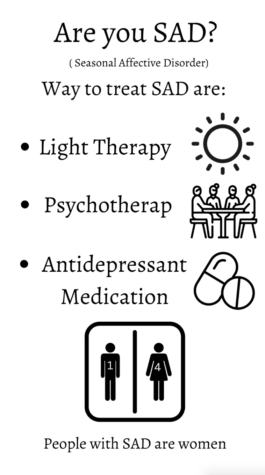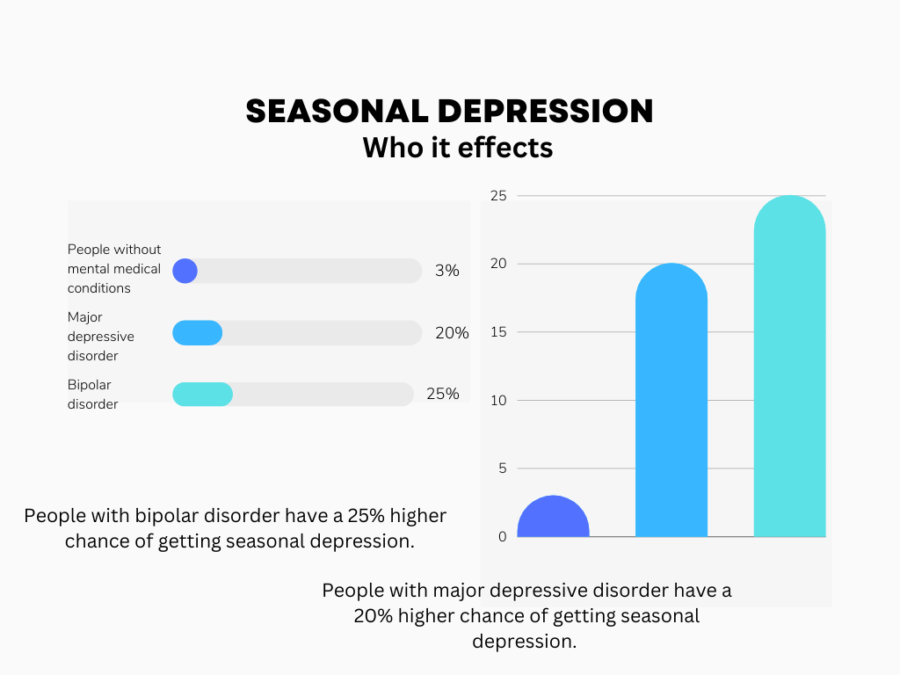Seasonal Affective Disorder: more than just SAD
December 16, 2022
Loss of interest in normal everyday activity and daytime sleepiness, along with feelings of irritability, despair, guilt and worthlessness, are common symptoms
of Seasonal Affective Disorder (SAD), mostly commonly know as seasonal depression.
SAD is different from everyday depression because it is a mood disorder characterized by depression that occurs at the same time every year, mostly in climates where there is less sunlight at certain times of the
year or has shorter days. Although, it can still affect people during the summer months.
Science teacher Addison Krebs said, “I typically started to feel the effects around fall when the days started to get much shorter, when it gets darker earlier, and when it started to get colder as well.”
Reed Swartzbaugh, 11, believes he starts to feel the effects when it starts to snow.
SAD is four times more common
in women than in men. While some children and teenagers get SAD, it usually does not occur in people younger than the age of 20. A person’s chance of experiencing SAD decreases with age. SAD is also more common in northern geographic locations because daylight decreases during winter.
SAD can take up energy, intensify carb cravings, and leave a person in a sad and irritable mood for months on end.
“[It makes] me less focused in class in general and makes it harder to come home and do homework,” said Swartzbaugh.
Ways to treat SAD, according to the National Institute of Mental Health, are light therapy, psychotherapy, antidepressant medications and vitamin D supplements.

Light therapy aims to expose people with SAD to bright light every
day to make up for the diminished natural sunshine in the darker months. A person will sit in front of a bright light box every day for about 30 to 45 minutes, usually first thing in the morning, from fall to spring.
Psychotherapy is to help people learn how to work through difficult situations. Treatment is normally occurs in twice weekly group sessions for six weeks and it focuses on pushing away peoples negative thoughts and turning them into positive thoughts. There is also a process called behavioral activation, which is when people schedule activities to put action first, encourage pleasant emotions and increase motivation.
Antidepressant medication, called selective serotonin reuptake inhibitors, are also used to treat SAD like it does for other types of depression. People with SAD use vitamin D, which is a supplement people take to provide calcium and phosphorus, helping to replace what the sun gives to people in the summertime that the wintertime does allow.
Everyone deals with their depression in their own way.
“For me it’s just taking time for myself, trying to get outside when
I can when it is daylight outside, trying to keep my emotions in check throughout the winter,” said Krebs.
A way to prevent SAD is to start the treatments that are listed above before the fall to help prevent or reduce depression. Light therapy has a high success rate of 60 or 80 percent, according to the ScienceLine.
Psychotherapy helps 75 percent of people according to American Psychiatric Association. If people
do start treatment before they feel the effects of SAD, according to The National Institute of Mental Health, people may experience less severe symptoms. Treatment may not prevent seasonal depression entirely.
Krebs’ coping mechanisms are his friends. He talks to them about SAD.
“I have tried many different coping mechanisms, one that seems to work is giving myself time limits for doing things,” said Swartzbaugh.



